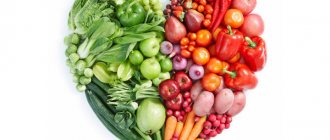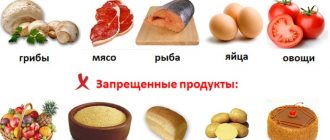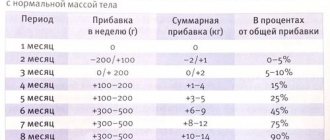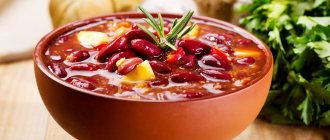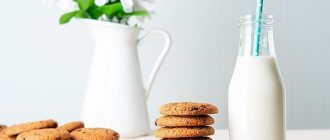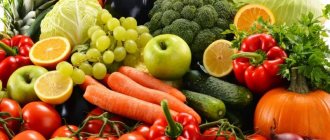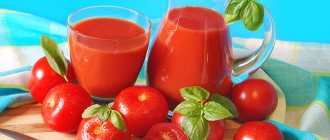Basic principles
To effectively lose weight and maintain optimal results, as well as well-being during the weight loss process, you should practice a comprehensive approach to nutrition, consisting of the following principles:
- Eliminate prohibited foods and drinks from the menu.
- Drink the optimal amount of water per day (30 ml per 1 kg of weight).
- Maintain daily caloric intake (from 1200 kcal to 1600 kcal). To calculate the energy value of foods, you can use the calorie table.
- The amount of BJU in the daily menu should be 40-45% proteins, 15-20% fats and 30-40% carbohydrates.
- Use the plate rule: half of the main meal portion should be vegetables, and a quarter each should be proteins (meat, cottage cheese) and carbohydrates (cereals).
- Consume fruits before 16.00, and allowed sweets (honey, dried fruits) before 12.00.
- Avoid overeating, as eating more food leads to an increase in daily caloric intake and slows down the weight loss process.
- Eat food slowly and chew thoroughly to promote proper absorption of nutrients.
- Control your salt intake, as excess salt leads to swelling.
Principles and rules of dietary nutrition for weight loss
Proper and balanced dietary nutrition for every day involves not only a certain set of foods allowed for consumption, but also a set of rules and recommendations that must be followed to achieve maximum results. It is recommended to use the following:
- Maintain meals at the same time every day. In order for digestion processes to occur smoothly, it is recommended to consume food at the same time. You should not take long breaks between meals. The maximum period can be no more than five hours.
- The last evening meal should be no later than three to four hours before going to bed. Night snacks can seriously strain the stomach and pancreas at a time when their activity is already decreasing and requires rest. As a result, deterioration of health, malaise, abnormal bowel movements, and pain in the abdominal area may occur.
- Food should be chewed slowly and thoroughly. This will allow for thorough preliminary preparation of food for processing, and will also help you feel full in a timely manner and prevent overeating.
- Drink more liquids. In this case, we are talking not only about the water regime (at least one and a half liters of water per day), but also about healthy drinks: green and black tea, herbal drinks, natural vegetable juices, sugar-free fresh juices.
- Use the principles of fractional nutrition. This method is actively used in dietetics as a universal way to improve the quality of any diet. In this case, each meal consumes only 200-250 grams of food, which allows you to maintain a small stomach volume. Due to frequent meals (three main meals plus two or three snacks), the practitioner experiences virtually no feeling of hunger with the diet menu, and also helps the body speed up metabolic processes.
- Periodically arrange fasting days. It is best to use mono-diets for this. For example, eat only oatmeal, kefir, cottage cheese, buckwheat porridge, fruits or vegetables all day. To speed up the process of losing weight and maintaining weight in the future, one or two days a week is enough.
- Allow yourself to eat your favorite foods from time to time. In order to prevent breakdowns, it is useful to periodically organize “small belly holidays” and eat food that brings pleasure in small quantities. Also, improving the quality of your favorite dishes with the help of healthy products can be an excellent way to prevent breakdowns. For example, prepare pizza with cottage cheese dough, bake confectionery products with the addition of whole grain flour and natural sweeteners.
A professional nutritionist can create a menu for a week of dietary nutrition, but it is not difficult to do it yourself using approved foods.
Be sure to read: How to lose weight without harm to your health during pregnancy?
What you can and cannot eat (table)
One of the principles of proper nutrition for weight loss is to use foods that do not cause fat deposition and will also provide the necessary level of energy throughout the day.
| What can you eat | What not to eat |
| Flour products | |
| Baking from whole grain wheat, rye, buckwheat, almond, oat flour without sugar | White bread made from premium wheat flour, sweet pastries |
| Meat | |
| Lean pork, rabbit, beef | Fatty pork, beef. Sausages |
| Bird | |
| Chicken, turkey | Duck, goose |
| Fish and seafood | |
| Cod, hake, chum salmon, pike, pike perch, mullet, pink salmon, tuna, mackerel, herring, trout, herring, pollock. Seaweed, shrimp, oysters | Salted, smoked fish, canned food, crab sticks |
| Eggs | |
| Hard-boiled, in the form of an omelet, as part of dishes | |
| Dairy products | |
| Cottage cheese (1-8% fat), kefir, yogurt, low-fat sour cream | Fat cottage cheese, sour cream, cream. Store-bought yoghurts with additives, glazed cheese |
| Cereals | |
| Green and brown buckwheat, bulgur, pearl barley, Artek cereal, oatmeal, brown rice. Peas, chickpeas, mung beans, lentils, beans | Instant oatmeal, sugar granola, white rice, semolina |
| Oil | |
| Olive, flaxseed, coconut, sunflower and other types of vegetable oils. Butter and ghee | Margarine, mayonnaise |
| Vegetables | |
| Cucumbers, tomatoes, carrots, onions, white cabbage, red cabbage, Chinese cabbage, cauliflower, eggplant, avocado, zucchini, bell pepper, spinach, lettuce, spinach, parsley, dill. Sauerkraut | Conservation. Mashed or fried potatoes |
| Fruits | |
| Apples, pears, plums, raspberries, cherries, strawberries, cherries, currants, mulberries, peaches, oranges, tangerines, grapefruit, apricots, kiwi. Limited: bananas (1 per day), grapes | |
| Dried fruits and nuts | |
| Walnuts, cashews, hazelnuts, nutmeg, pistachios, almonds (no more than 20 g per day). Prunes, dates, figs, apricots, mango, dried apricots (no more than 25 g per day) | Peanuts, raisins and dates in large quantities |
| Dessert | |
| Honey, date syrup, sweeteners, dark chocolate | Confectionery, ice cream, sweets, milk and white chocolate, cookies |
| Beverages | |
| Black, green, mint, chamomile tea, coffee, chicory, barley drink without sugar | Alcohol, sweet carbonated drinks |
Where to begin
Many people start using a healthy diet system and expect instant results. However, it is primarily aimed at improving the health of the person losing weight, and therefore requires gradualness. Too extreme diets allow you to lose up to 10 kilograms of weight, depending on your initial body weight. However, this is fraught with health problems and sagging skin. The best option is to lose weight by 0.5-1 kilograms per week, and proper nutrition allows you to achieve such results painlessly.
Many nutritionists and fitness trainers do not recommend abruptly switching to a dietary nutrition system, as this can cause stress for the body and the practitioner himself. There are several common mistakes when losing weight that should be eliminated from the very first day of transition:
- The desire to get quick results. As mentioned above, weight loss of up to a kilogram per week is considered safe.
- Carrying out hunger strikes on your own. Cutting your diet too much can cause not only stress, but also breakdowns in the future, which can be quite difficult to stop.
- Taking additional medications and dietary supplements that promise quick results. Currently, miracle cures for weight loss do not yet exist, and thoughtless use of medications can be dangerous to health and life.
- The use of excessive physical activity. Too much load can cause overtraining, and then regression of results.
- The use of various external anti-cellulite remedies, body wraps, slimming baths, etc. as the main ones. These methods can be used solely as auxiliary ones. They are not suitable as basic ones.
Be sure to read: Simple and effective ways to lose belly fat in 2 weeks
First of all, when switching to proper nutrition, you need to relax. You can get the same pleasure from low-calorie food as from high-calorie food if you find the right approach to it.
Today, a huge number of dietary analogues of various high-calorie dishes have been obtained, which can bring no less pleasure. So, for example, you can prepare several versions of any desserts based on cottage cheese or whole-ground oatmeal with the addition of a natural sweetener (stevia, sucralose, Jerusalem artichoke syrup, honey, etc.). The gradual abandonment of harmful things in favor of useful things is the key to a good start.
How to create a menu
In order for nutrition to be beneficial and contribute to weight loss, it is important to follow the basic rules for creating a menu for the week, taking into account the physiological needs of the body:
- consume a daily protein allowance (1-1.5 grams per kilogram of weight), which is distributed throughout the day;
- for breakfast, it is recommended to prepare dishes consisting of protein and slow carbohydrates for a long-term feeling of fullness, for example, omelet and porridge, oatmeal with curd filling, etc.;
- lunch should consist of protein, carbohydrates and green vegetables to provide the body with vitamins and fiber;
- the number of meals per day is calculated individually depending on the daily routine;
- You should not eat food without feeling hungry, since eating even healthy foods without a physiological need leads to overeating.
Detailed menu
The menu is compiled taking into account the principles of healthy eating, so it includes 3 main and 2 additional meals. Products consumed during snacks normalize the metabolism of the human body, which helps improve performance.
Menu for 7 days
| Days of the week | Breakfast | Dinner | Dinner |
| Monday | Rice porridge with milk, bread, cocoa | Pea soup, potatoes with chicken liver, cucumber, compote, bread | Pollock with carrots and onions in sour cream, tea, bread |
| Tuesday | Eggs Benedict, tea, bread | Pea soup, merchant buckwheat, tomato, compote, bread | Pasta with mushrooms, bread, cocoa |
| Wednesday | Merchant style buckwheat, bread, tea | Borsch with canned beans, homemade dumplings, tomato, bread, compote | Zucchini casserole with chicken, bread, tea |
| Thursday | Rice porridge with milk, cocoa, bread | Borscht with beans, potatoes with chicken liver, cucumber, bread, compote | Potato pizza, cocoa |
| Friday | Eggs Benedict, tea, bread | Beef kharcho, pollock with carrots and onions in sour cream, bread, compote | Merchant style buckwheat, tomato, bread, tea |
| Saturday | Cheesecakes, tea | Creamy soup with melted cheese, pasta with mushrooms, bread, compote | Homemade dumplings, bread, tea |
| Sunday | Potato pizza, tea | Beef kharcho, zucchini casserole with chicken, bread, compote | Potatoes with chicken liver, cucumber, bread, tea |
Important!
Nutritionists advise eating fruits, nuts and vegetable salads at 10-11 a.m., which help produce additional energy, and at 3-4 p.m., fermented milk products that restore the functioning of the gastrointestinal tract after eating the main amount of food.
Healthy nutrition menu for the week
An approximate menu of proper nutrition for every day consists of hearty and healthy dishes, taking into account the balance of proteins, fats and carbohydrates, which not only contribute to effective weight loss, but also provide the body with the necessary level of energy throughout the day.
Monday
- Breakfast: whole grain bread sandwich, boiled egg, hard cheese, coffee with milk;
- Lunch: turkey chops, stewed bulgur, vegetables, apple;
- Afternoon snack: cottage cheese casserole with berries;
- Dinner: chicken salad with cucumbers and cabbage.
Tuesday
- Breakfast: cheesecakes (with banana instead of sugar), sour cream, tea or coffee;
- Lunch: tuna salad, banana;
- Afternoon snack: liver pancakes, salad with tomato and cucumber;
- Dinner: baked salmon with broccoli.
Wednesday
- Breakfast: rye bread, avocado, cheese, coffee with milk;
- Lunch: grilled turkey fillet, boiled buckwheat, fresh cucumber, kiwi;
- Afternoon snack: vegetable roll in lavash made from whole grain flour;
- Dinner: cottage cheese and protein casserole.
Thursday
- Breakfast: whole grain pancakes, cottage cheese with berries;
- Lunch: chicken fillet, durum wheat pasta, tomato and cheese salad, pear;
- Afternoon snack: baked apples and peaches;
- Dinner: boiled shrimp, lettuce with egg, onion and lemon juice.
Friday
- Breakfast: 3 egg omelet with tomatoes, green tea;
- Lunch: baked turkey with zucchini and bell pepper, quinoa, cherries;
- Afternoon snack: banana-curd puree;
- Dinner: salmon and cauliflower pie.
Saturday
- Breakfast: rye bread sandwich with cheese and avocado, coffee;
- Lunch: boiled shrimp, brown rice, Chinese cabbage salad, apple;
- Afternoon snack: cottage cheese with yogurt and nuts;
- Dinner: baked champignons, salad.
Sunday
- Breakfast: oatmeal, cottage cheese with nuts;
- Lunch: steamed chicken cutlets, funchose with vegetables, fruit;
- Afternoon snack: Greek yogurt with berries;
- Dinner: halibut, salad.
Principles of proper nutrition when losing weight
It is important to remember that the main principle of effective weight loss is to consume fewer calories per day than you burn. If you build your diet according to the above principle, then the body will make up for the lack of calories by breaking down fat reserves, which will contribute to weight loss.
When developing a proper nutrition menu for every day for weight loss with recipes, you should take into account that the main part of the diet should be food consisting of complex carbohydrate compounds that will provide a feeling of satiety for a long period of time.
At the same time, the process of losing weight every day will not be as intense as when following more aggressive diets, but the likelihood that the eliminated kilograms will not return will be several times higher, especially if the correct diet is taken as a habit and followed constantly.
Healthy human nutrition consists of the following main aspects:
- eating when a feeling of hunger occurs, but if there is no feeling of hunger, then the food consumed will be stored in the form of fatty deposits;
- food should be chewed as thoroughly as possible, without rushing;
- follow a four-meal regimen, that is, eat at least 4 times a day, with obligatory healthy snacks between main meals, which will help not to exhaust your body with a painful feeling of hunger.
Another equally important point of proper and healthy nutrition is drinking liquid only 15-20 minutes after eating. Drinking liquid during meals will prevent the complete absorption of ingested food products, which subsequently begin to accumulate in certain areas of the intestine and gradually decompose.
Video
https://youtu.be/B7xHYk_pOno
Recipes
The large number of available food products on the menu makes it possible to prepare delicious dishes from meat, fish, cereals and cottage cheese, as well as use almost all methods of heat treatment of food.
Tomato puree soup
To prepare the soup, you will need 800 g of tomatoes, two onions and garlic (2 cloves), carrots and herbs.
The onion is cut into rings, the carrots are grated and sautéed in oil for 5-7 minutes. Next, the dressing is mixed with tomatoes and simmered over low heat for 10 minutes. After cooking, the soup is seasoned with herbs, salted and seasonings are added, and then chopped using a blender. Serve tomato soup with sour cream.
Chicken with spinach
Ingredients: chicken fillet (half a kilo), frozen or fresh spinach (250 g), hard cheese (100 g), onions (1 pc.), several cloves of garlic, sour cream (200 g), vegetable oil and seasonings.
The chicken fillet is cut lengthwise into several pieces approximately 1 cm thick, salted and peppered. Also chop the onion and wash the spinach. Next, place 1 tbsp on the heated frying pan. l. butter, spinach, sour cream, pressed garlic and salt. Simmer for 5-7 minutes.
Place chicken pieces in the bottom of the baking dish, followed by sautéed spinach and grated cheese. The dish is baked in the oven for 15-12 minutes.
Baked beef cutlets
To prepare the cutlets, use 1 kg of minced beef, an onion, 200 grams of white cabbage, 2 eggs, salt and pepper.
The onions are cut and crushed with an immersion blender, and the cabbage is twisted in a meat grinder like minced meat. Mix all the ingredients, form cutlets and place on a baking sheet covered with parchment paper.
The cutlets are baked in the oven for 40 minutes. The dish is served with vegetable salad.
Okroshka with kefir
To prepare okroshka you will need stewed or boiled chicken breast, boiled eggs, radishes, avocado, cucumbers, parsley, dill, onions, kefir, and mineral water.
The breast, eggs, cucumbers, avocados and radishes are cut into cubes, the greens are chopped. Next, the ingredients are poured with kefir and mineral water (half a glass each), salt is added.
Omelette with shrimp
Ingredients for the omelette: 200 g each of frozen shrimp and broccoli, 4 eggs, 0.5 cups of milk, salt, herbs.
Beat eggs with milk and salt. Place shrimp and broccoli in a non-stick frying pan and pour in the whipped mixture. Cook the omelette for 5-7 minutes, covered, over low heat. Before serving, the omelet can be sprinkled with herbs.
Baked champignons
To prepare the dish you will need champignons (700 g), balsamic vinegar (40 ml), 3 cloves of garlic, vegetable oil (2 tbsp.), salt, pepper and other spices to taste.
Preparation of the marinade: chop the garlic and mix with salt, spices, oil and vinegar.
Mushrooms should be washed and large champignons should be cut into 2-3 pieces. After which the mushrooms are poured with marinade, mixed and left for 25-30 minutes. Next, the champignons are baked on parchment paper or a baking sheet for 20 minutes at a temperature of 200 degrees.
Menu for every day for weight loss
During the period of losing weight, it is important to learn one simple rule: the portion size of each dish should not be larger than the size of your own fist. As additional snacks, it is allowed to consume 2 servings of vegetable soups or green vegetables per day.
Video
In addition to water, it is recommended to drink:
- decoctions of medicinal herbs;
- green tea with jasmine or bergamot;
- natural juices from vegetables;
- low-fat kefir or yogurt.
In order to eat right and lose weight effectively, it is recommended to use the following sample menu for a week for weight loss:
| Weekly menu for weight loss | ||
| Days of the week | Eating | Menu |
| Monday | Breakfast | 200 gr. oatmeal |
| Lunch | 50 gr. hard cheese, a glass of tea | |
| Dinner | Soup – 300 gr.; Vegetable salad – 150 gr.; Bread – 2 slices. | |
| Dinner | 80 gr. boiled veal meat; 100 gr. stewed vegetables. | |
| Tuesday | Breakfast | Cottage cheese – 150 gr.; Dried fruits – 200 gr. |
| Lunch | Kefir – 200 ml; Nuts – 50 gr. | |
| Dinner | Steamed fish – 120 gr.; Raw vegetables – 150 gr. | |
| Dinner | Egg omelet – 180 gr.; Vegetable salad – 150g. | |
| Wednesday | Breakfast | Muesli – 150g; Dried fruits – 200 gr. |
| Lunch | Juice – 200 ml; Curd pudding – 150 gr. | |
| Dinner | Stewed mushrooms – 120 gr.; Fresh cucumber – 100 gr. | |
| Dinner | Cottage cheese – 200 gr.; Vegetable salad – 150 gr. | |
| Thursday | Breakfast | Egg omelet – 180 gr.; Bran bread - one slice. |
| Lunch | 250 grams of fruit | |
| Dinner | Steamed fish – 200 gr.; Fresh cucumber and tomato – 150 gr. | |
| Dinner | Stewed beans – 200 gr.; Egg | |
| Friday | Breakfast | Homemade cheese – 100 gr.; Banana |
| Lunch | Hazelnuts – 50 gr.; Yogurt – 200 ml. | |
| Dinner | Soup with cabbage – 300 gr.; Buckwheat porridge – 150 gr. | |
| Dinner | Grilled beef steak – 150 gr.; Vegetable salad – 150 gr. | |
| Saturday | Breakfast | Milk rice porridge with honey – 200 g; A glass of tea. |
| Lunch | Apple; Yogurt – 200 ml. | |
| Dinner | Chicken puree – 150 gr.; Beetroot salad – 200 gr. | |
| Dinner | Grilled fish – 150 gr.; Fresh vegetables – 150g; Crispbread – 2 pcs. | |
| Sunday | Breakfast | Soft-boiled egg – 2 pcs.; Coffee without sugar - a glass. |
| Lunch | Cottage cheese with dried apricots – 150 gr. | |
| Dinner | Ukha – 300 gr.; Beef goulash – 150 gr.; Stewed vegetables as a side dish. | |
| Dinner | Pollock cooked in a double boiler – 200 g; Beetroot and prune salad – 150 gr.; Rye bread – 2 pcs. | |



